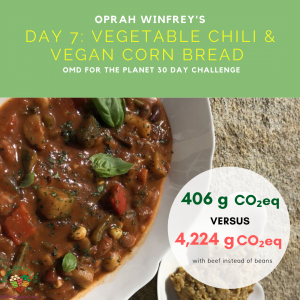This veggie chili is what Oprah had on Day 7 of her One Meal a Day for the Planet 30 day challenge—perfect to enjoy on a cold fall day. Per serving, the carbon footprint of this recipe is 406 g CO2eq (there are four servings in the recipe). For comparison, this recipe made with beef instead of beans has a footprint of 4,224 g CO2eq per bowl (even using a conservative value for the carbon footprint of beef). This big difference is due both to the low carbon footprint of beans and the particularly high carbon footprint of beef and is equivalent to a 17 mile drive per serving (or a 68 mile drive for the whole recipe). Plus, beans are nutrient dense, protein rich foods and are associated with numerous health benefits including reduced cancer risk and improved heart health.

The water required to produce beans is 1,700 L per kg, compared to 6,600 L per kg for beef.
To meet the Paris Climate Accord, the U.S. would need to reduce its carbon footprint by about 326 million metric tonnes per year. If we divide that by the people in the country and the days in a year, it’s about 2,700 g CO2eq per person per day!! So this bowl of chili fulfills a personal pledge to the Paris Climate Accord for a day and then some! This calculation shows how much we can achieve through shifts in our diets away toward lower carbon footprint foods.
This recipe was created by Oprah’s chef Raymond Weber, and you can find all of the recipes Oprah Magazine and online at @oprahmagazine. Photo credit: @oprahmagazine.
Thank you to Yuhang Cai and Rachel Tsao for their help using the the Meals for the Planet recipe calculator and creating the inforgraphic. Thanks to Brian Cook and Katie Osborn for their excellent work making the calculator user-friendly. Please email us at jennyjay@ucla.edu if you would like it sent to you.
Carbon footprint data are from: Heller, M.C. and G.A. Keoleian. 2014. Greenhouse gas emission estimates of U.S. dietary choices and food loss. Journal of Industrial Ecology. doi: 10.1111/jiec
Water data are from Leach et al. 2016. Environmental impact food labels combining carbon, nitrogen, and water footprints. Food Policy. 61:213-223.


Recent Comments